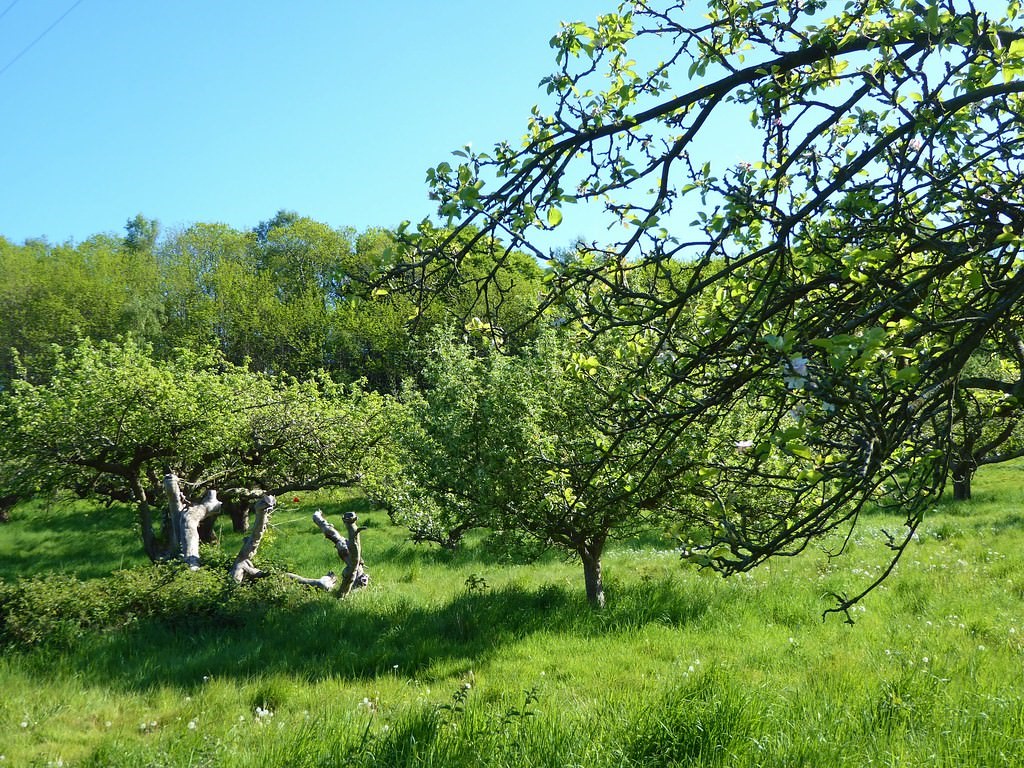
Traditional Orchards: The new, old biodiversity haven
Georgia Timpson, our Graduate Landscape Architect has a background in Environmental Science and shares her knowledge on traditional orchards and how they these havens can connect us to our cultural past.
What are Traditional Orchards?
September is the interim between summer and autumn and as the landscape changes from one of growth to dormancy, one of the areas that are undergoing the most change is fruiting orchards.
Traditional Orchards were once a common sight within rural England, with low-density planting of a wide combination of fruiting trees often found around farmhouses or villages.
These areas would have provided shelter for livestock, alternative income for farming communities and a wide range of fruit for local families including now less common apricot, medlar, peach and quince trees. Orchards are of course, still an integral part of the make-up of the rural British landscape, and September ushers in the harvesting period which still affects the demographics and travel habits of a vast number of rural communities.
An influx of workers from home and abroad to fruit-growing farms is a migration that has occurred for hundreds of years. During the rapid growth of Kentish fruit farming in the late 19th and early 20th century, newly built railways allowed workers from London to flock to the orchards of rural farms to help bring in the harvest.
The area referred to as ‘The Garden of England’, continues to be a hub for fruit growing today.
The National Fruit Collection is kept at Brogdale Farm, close to Faversham and is still home to one of the largest fruit collections in the world with over 3,500 varieties kept.
Throughout Kent, the landscape is shaped by large commercial orchards growing for domestic and international markets. Traditional orchards, however, are an ecosystem all of their own.
‘Traditional Orchard’ refers to the low-density planting of vigorous rootstock varieties of fruit and nut trees, often managed in a low-intensity way on permanent grassland.
Not only do these orchards provide key habitat for native flora and fauna, they also help to reinforce landscape character within rural and heritage farming areas.
They are a designated priority habitat owing to their ability to attract and support an abundance of wildlife. This is because they are a mosaic habitat, meaning they encapsulate a number of different micro-habitats within them. In a traditional orchard, there may be, pasture, meadow grassland, wood and scrubland as well as being edge by mature and dense hedgerows.
Alongside this abundance of habitat choice, the grassland is frequently unimproved and there is minimal usage of herbicides and pesticides.
A Case Study: No Man’s Orchard
A peaceful and beautiful example of a traditional orchard can be found in Chartham near Canterbury – it has the unique name of No Man’s Orchard. The name “No Mans” traditionally means that the land overlaps two ownership areas and consequently is not owned by anyone man (or woman). This is supported by the parish boundary, which runs through the middle of the orchard.
The 10 acres of the Orchard is rich with trees, including about 152 mature Bramley apple trees and 45 pollinators (Howgate Wonders, James Grieve, Worcester’s), which were originally planted in 1947. Some of the Bramley’s have even had pollinators grafted onto their tops.
No Mans Orchard is one of the few surviving traditional orchards in the area and protected under the Countryside Stewardship Scheme. It was designated as a Site of Nature Conservation Interest in 1995 and forms part of Blean Woods South SNCI AS/SW/CA 17. It has also been designated as a Local Nature Reserve.
No herbicides have been used in the Orchard for a number of years and no sprays have been used since 1993, so the fruit is now officially organic.
It is an extremely attractive and peaceful space, well hidden from the road by woodland, mostly Sweet Chestnut coppice. It has some of the largest apple trees in the district, with beautiful blossoms in spring and early summer.
The orchard allows members of the public to ‘adopt a tree’, meaning that you financially support the orchard and get to harvest the apples from your tree if you wish.
Connecting us to our cultural and biological past
In short, traditional orchard habitat is a rarely disturbed space that holds the key ingredients for a healthy ecosystem, varied food sources, and a variety of shelters.
Planting choices should be based on the historic and cultural understanding of an area, the planting of cobnuts in Kent is a native and traditional alternative to more commercial species.
By reinstating these species within a landscape, it is possible to regenerate the ecological makeup of a newly planted area.
Traditional orchards can be a successful method for establishing a sense of local community – particularly within sites that have a history of traditional orchard planting, and their management needs careful consideration with the client from the outset.
Orchards can connect new developments with the cultural and biological past of our sites, whilst creating valuable habitat, but their addition should be a thoughtful one, paying care and attention to their future use.
